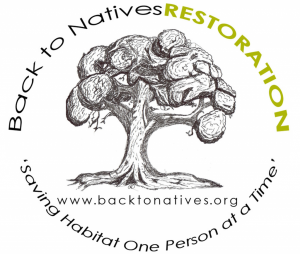
Dear BTN Supporters, (Volunteers, Members, Advisory Council, Board, Donors),
We NEED YOU! Without your financial support, this could be the final year of Back to Natives Restoration. Have you volunteered with Back to Natives? Interned? Served on the Board of Directors or Advisory Council? Back to Natives Needs YOU! Funding is tight, and we have projects that need staff to lead and train volunteers to perform habitat restoration as well as grow more locally native plants in the Back to Natives Nursery. We also need supplies and equipment to secure our Barns and the BTN Nursery grounds. For that, we need your financial support.
I am not asking for much, I personally have committed ALL of my savings, and MORE to this past season. But I am supposed to be staff, not a donor. I am an employee and have no money left to give and must pay my own mortgage, and loans back, that I took out to pay BTN’s debt. Please help me help Back to Natives! I don’t have anything else to commit. I have even taken out personal loans and maxed my credit card to be sure BTN can continue its mission. But…
BTN can’t do it without you. Back To Natives Restoration Needs your support. Just $5 per month is all I ask. Is that too much in comparison to my savings? $5 per month, with EVERYONE on this email list, and social media friends, pledging $5 per month, BTN’s funding would increase by $70,000 per month! Right now we have only raised $40,000 for the Fiscal year 2018, since July 2018(and ends June 30, 2019). But our budget calls for $240,000 to even come close to achieving our habitat restoration and native plant propagation goals. Can you help? Just $5 per month.
You can also contact us to ask what you can pay for directly, to help our mission. we are not seeking items that can be stolen. We are seeking funding for staff, and operations to perform our mission, as well as equipment to make our BTN Nursery more secure. Like steel bars, building materials, steel fences, concrete and more.
You can use our merchant services online to make a donation or become a member. You can still use PayPal, or select “use credit card” and use our secure intuit merchant services!
Even better for BTN, as in no fees taken out of your donation, enroll in Bill Pay through your financial institution. Pledge $5 per month, or more if you can afford more, and have your financial institution send the check to:
Back to Natives Restoration
PO BOX 10820
Santa Ana, CA 92711
You’re always being asked to help with causes that are far away. Those causes are important, but if you really want to see results from your efforts and from your donations, act locally. Donations help to ensure that Back to Natives service learning and habitat restoration programs continue – and we are a 501(c)3 non-profit public charity – so your donations are tax deductible.
If you think Internships should be paid, then help us fund those paid Internships!
You can choose to donate once or on a monthly basis to help assist Back to Natives with the many programs and projects we have in the works. Your small monthly donation will be a HUGE help to Back to Natives! Pledge today. We Need you, to help save the world right here in the County and Southern California!
Reginald I. Durant
Executive Director
Back to Natives Restoration, a 501(c)(3) public charity
WWW.BACKTONATIVES.ORG/donate
Donate!
Become a member!
Forward this post to your friends and family that care about the environment!







 Spend more time enjoying your garden and less time maintaining it. Natives require less work at garden chores such as mowing, pruning, fertilizing and dividing. California native plants are adapted to a wide variety of growing conditions and fine native plant choices exist for virtually any garden environment. The biodiversity promoted by a native plant garden will reward the owner with satisfying experiences of discovery and observation, not only of the plants themselves, but a host of other species… birds, insects, mammals, etc. A good native plant garden complements the indigenous habitat and by growing plants found in our resident plant community, we bring in all sorts of nearby creatures dependent on that habitat. In a small but significant way, we as native plant gardeners begin to help secure a connection with the natural world that is infinitely more satisfying than mowing the lawn.
Spend more time enjoying your garden and less time maintaining it. Natives require less work at garden chores such as mowing, pruning, fertilizing and dividing. California native plants are adapted to a wide variety of growing conditions and fine native plant choices exist for virtually any garden environment. The biodiversity promoted by a native plant garden will reward the owner with satisfying experiences of discovery and observation, not only of the plants themselves, but a host of other species… birds, insects, mammals, etc. A good native plant garden complements the indigenous habitat and by growing plants found in our resident plant community, we bring in all sorts of nearby creatures dependent on that habitat. In a small but significant way, we as native plant gardeners begin to help secure a connection with the natural world that is infinitely more satisfying than mowing the lawn.